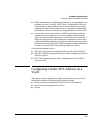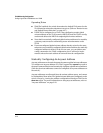
4-18
IPv6 Addressing Configuration
Duplicate Address Detection (DAD)
Note: Neighbor and router solicitations must originate on the same VLAN as the
receiving device. To support this operation, IPv6 is designed to discard any
incoming neighbor or router solicitation that does not have a value of 255 in
the IP Hop Limit field. For a complete list of requirements, refer to RFC 246.
When a pair of IPv6 devices in a VLAN exchange communication, they enter
each other's IPv6 and corresponding MAC addresses in their respective
neighbor caches. These entries are maintained for a period of time after
communication ceases, and then dropped.
To view or clear the content of the neighbor cache, refer to “Viewing and
Clearing the IPv6 Neighbors Cache” on page 5-2.
For related information, refer to:
■ RFC 2461: “Neighbor Discovery for IP Version 6 (IPv6)”
Duplicate Address Detection (DAD)
Duplicate Address Detection verifies that a configured unicast IPv6 address
is unique before it is assigned to a VLAN interface on the switch. DAD is
enabled in the default IPv6 configuration, and can be reconfigured, disabled,
or re-enabled at the global config command level. DAD can be useful in helping
to troubleshoot erroneous replies to DAD requests, or where the neighbor
cache contains a large number of invalid entries due to an unauthorized station
sending false replies to the switch's neighbor discovery queries. If DAD
verifies that a unicast IPv6 address is a duplicate, the address is not used. If
the link-local address of the VLAN interface is found to be a duplicate of an
address for another device on the interface, then the interface stops
processing IPv6 traffic.
DAD Operation
On a given VLAN interface, when a new unicast address is configured, the
switch runs DAD for this address by sending a neighbor solicitation to the All-
Nodes multicast address (ff02::1). This operation discovers other devices on
the VLAN and verifies whether the proposed unicast address assignment is
unique on the VLAN. (During this time, the address being checked for unique-
ness is held in a tentative state, and cannot be used to receive traffic other
than neighbor solicitations and neighbor advertisements.) A device that
receives the neighbor solicitation responds with a Neighbor Advertisement


















